1. What is the Cambodian New Year Called?
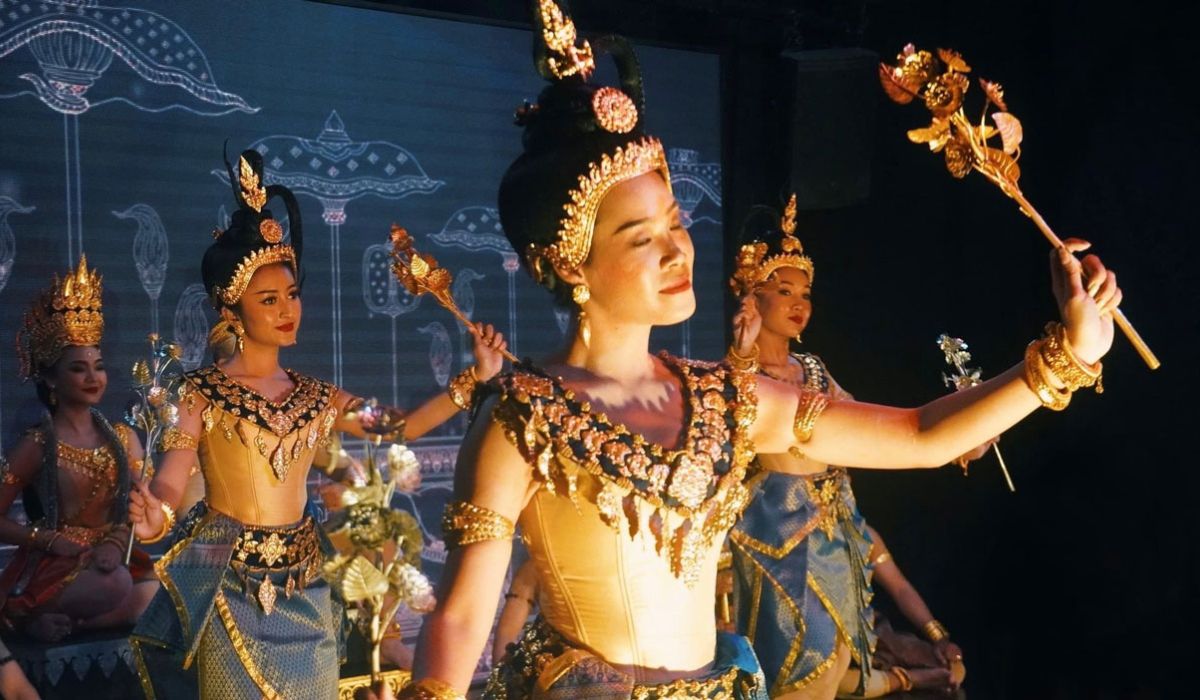
Cambodian New Year, also known as Choul Chnam Thmey, is a traditional celebration of the New Year according to the Gregorian calendar in Cambodia. A three-day public holiday in the country, the celebration begins on New Year's Day, usually falling on April 13th or 14th, which marks the end of the harvest season when farmers enjoy the fruits of their labor before the rainy season begins. Khmer people living abroad may choose to celebrate over the weekend rather than specifically from April 13th to April 16th. The Khmer New Year coincides with the traditional New Year celebrations in some parts of India, Bangladesh, Nepal, Sri Lanka, Myanmar, Laos, and Thailand.
2. History and Origin of Cambodian New Year
The origins of Cambodian New Year can be traced back to ancient Indian and Hindu traditions. Initially, the festival was celebrated at the end of the harvest season, a time of abundance and prosperity. Over time, the festival became an integral part of Cambodian culture, with unique customs and traditions emerging that reflect the country’s history and identity.
During the Khmer Rouge regime in the 1970s, the celebration of Cambodian New Year was banned. Only after the fall of this regime was the festival revived and celebrated once again.
3. Three Days of Cambodian New Year Celebrations

Day 1: Moha Songkran – The Day of Blessings
Moha Songkran is the first day of the New Year celebration and marks the opening of the Khmer New Year.
Customs: On this day, each family member works hard to clean and decorate their home in the best way possible, along with arranging food and drinks on the table to welcome the angels. Buddhists usually prepare meals to offer to monks to seek blessings.
Beliefs: According to Khmer tradition, the world was created by God, and His angels take care of all of us.
Day 2: Virak Vanabat – The Donating Day
The second day of Khmer New Year is a day of giving gifts to the elders in the family, including parents and grandparents. Most native Cambodians also engage in charity by donating money, food, and clothing to those less fortunate.
Customs: In the evening, everyone in the household, including both the elderly and the young, goes out to visit religious temples and perform the traditional ritual of building sand stupas on the ground.
Beliefs: In Khmer culture, this ritual is believed to bring prosperity and longevity to the Cambodian people.
Day 3: Vereak Laeung Sak – Welcoming the New Year
The third and final day of Khmer New Year is the day to say goodbye to the old year and welcome the new year with new hopes.
Customs: According to local customs, people celebrate this day by performing 'Pithi Srang Preah,' a ritual of washing and cleansing Buddha statues with fragrant water.
Beliefs: The Pithi Srang Preah ritual symbolizes washing away all evils and receiving blessings from the Almighty. Many locals also wash the hands and feet of their parents or elders as a way to appease them and apologize for past mistakes. During Khmer New Year in Cambodia, make yourself feel like a local by joining in the celebrations. If you’ve planned a trip to Cambodia during this time, make it even more special during the upcoming Khmer New Year.
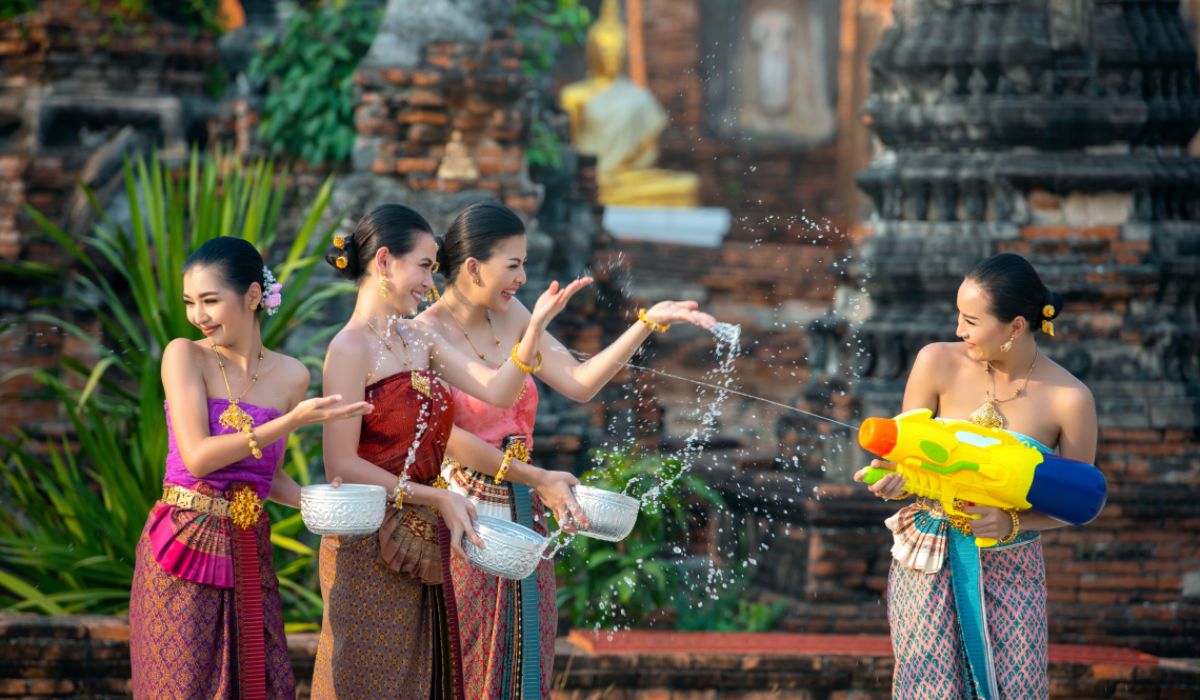
4. Symbolism and Cultural Significance
The Cambodian New Year is filled with rich meaning and symbolism. Many of the customs and practices of the festival are believed to bring good luck, health, and prosperity for the coming year. The festival is a time for spiritual cleansing, house purification, and paying respects to family, friends, and ancestors.
One of the most significant traditions of the Cambodian New Year is the water-splashing custom. This act is performed as a symbol of cleansing and purification, believed to wash away the sins and bad luck of the previous year. It is also a way to show respect to elders and receive blessings for the coming year.
Another important tradition is the construction of sand stupas, also known as "chedi." These small structures made of sand are decorated with flags and flowers. They are believed to bring good fortune and prosperity and are often built in front of homes and businesses.
Khmer New Year is also a time to prepare special foods. One of these is "kralan” - a type of cake made from steamed rice mixed with beans or peas, grated coconut, and coconut milk. This mixture is stuffed inside a bamboo stick and slowly roasted.
5. Why Does the Cambodian New Year Take Place in April?
Choul Chnam Thmey is a national holiday celebrated by Cambodians every year. This is the time when Cambodians have free time after harvesting rice and other crops. This event is Cambodia's biggest event and lasts for three days, from April 13th, 14th to 15th (in a specific year, it may be from April 14th to 16th). For example, this year, the festival takes place from April 13th to April 16th. But in 2025, the festival will begin from April 14th to 16th.
Why is the Cambodian New Year celebrated in April? In the early years, Khmer New Year was celebrated in the first lunar month, usually in November or December. However, during the Angkor period in the 13th century, the Khmer King revised the date of the new period to coincide with the fifth Khmer month of the lunar calendar, setting the new date as April. Therefore, the Khmer New Year marks the end of the harvest season but occurs before the rainy season. In fact, this change has been useful both then and now, as November to March is the peak season for farmers.
6. Where to Celebrate Cambodian New Year?
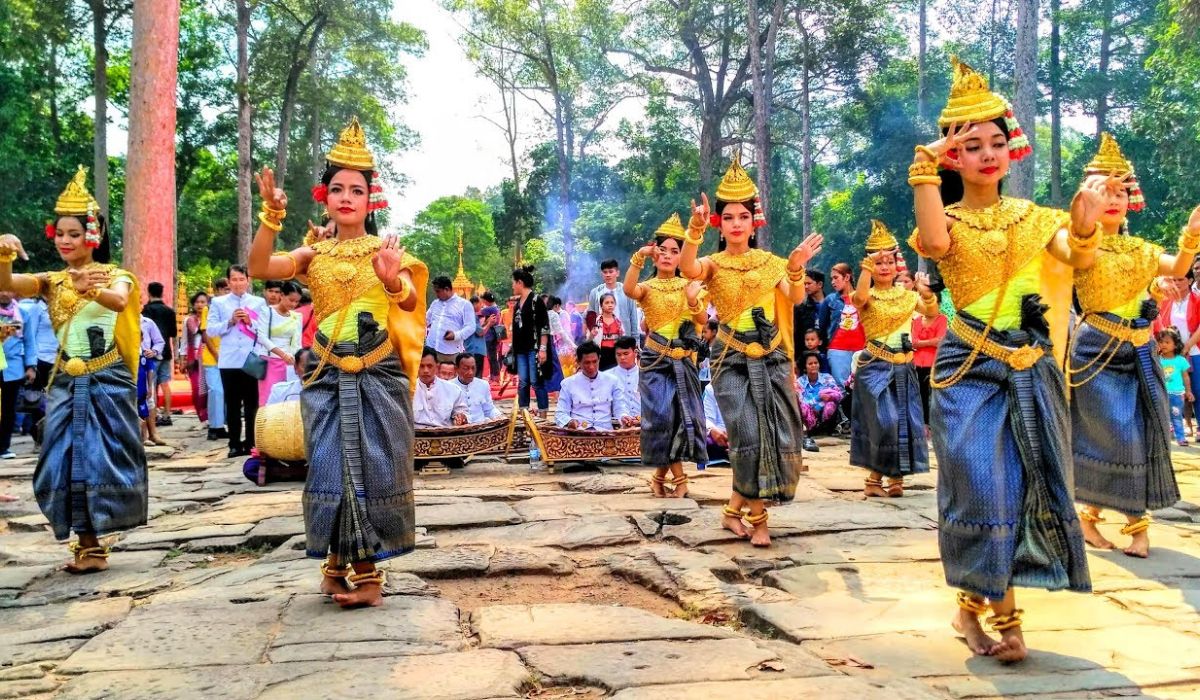
Khmer New Year 2024 will be celebrated across Cambodia; however, some places are especially famous for their festive spirit:
-
Siem Reap – The historic city near Angkor Wat becomes the focal point for celebrations, with special events and traditional games taking place near the ancient temples.
-
Phnom Penh – The capital, although many locals return to their hometowns, still hosts lively celebrations at temples and public areas.
-
Battambang – Known for its traditional Khmer houses and old-world charm, Battambang offers a more relaxed but culturally rich and traditional celebration.
7. Traditional Games & World Records in Cambodian New Year
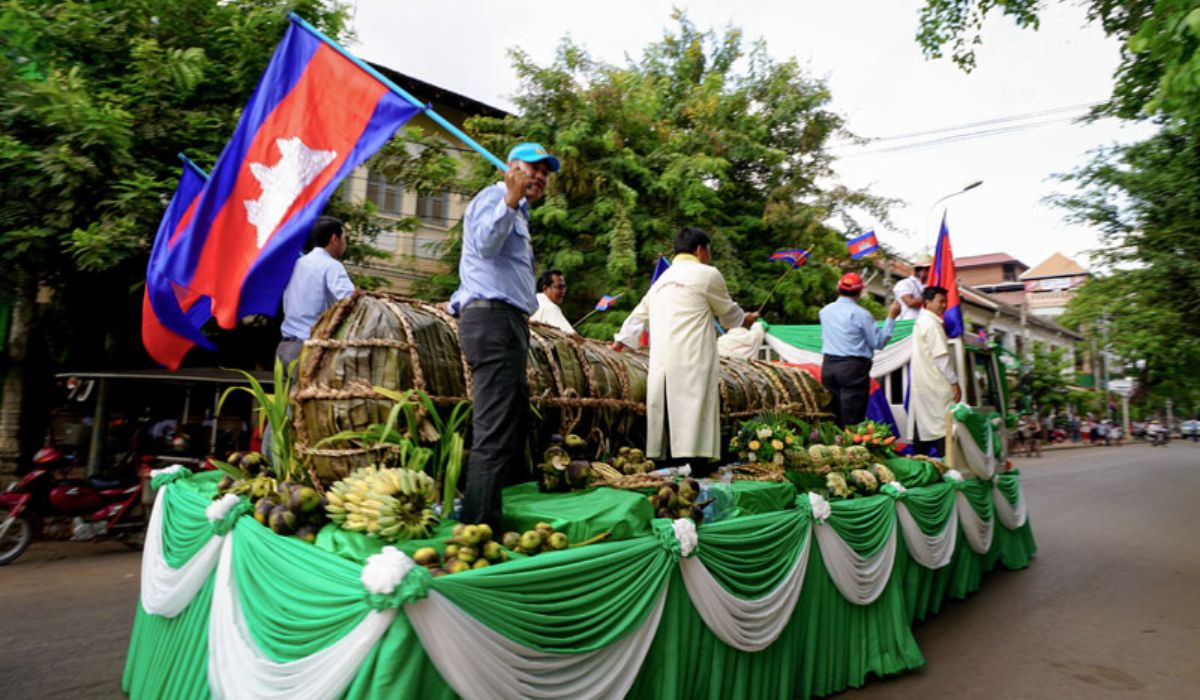
Cambodians can be very creative when they have three days, possibly four days, to stay busy with events. Children, adults, and even the elderly participate in festive activities, including games, competitions, and world records. For example, Cambodia has won the world record for the "Nom Ansom," the largest sticky rice cake ever made in Siem Reap. The heaviest cake weighed 8,906 pounds and 10 ounces.
While the Khmer New Year has a serious atmosphere, it is also a joyous celebration with family, friends, and the entire nation. The last day of the New Year is filled with lively atmosphere, fireworks, and street parties all over Cambodia. Every corner of the country and Khmer people worldwide add their own flair to this special holiday, making each celebration uniquely special. They have devised traditional games during the three-day series that you can also try:
Chol Chhoung
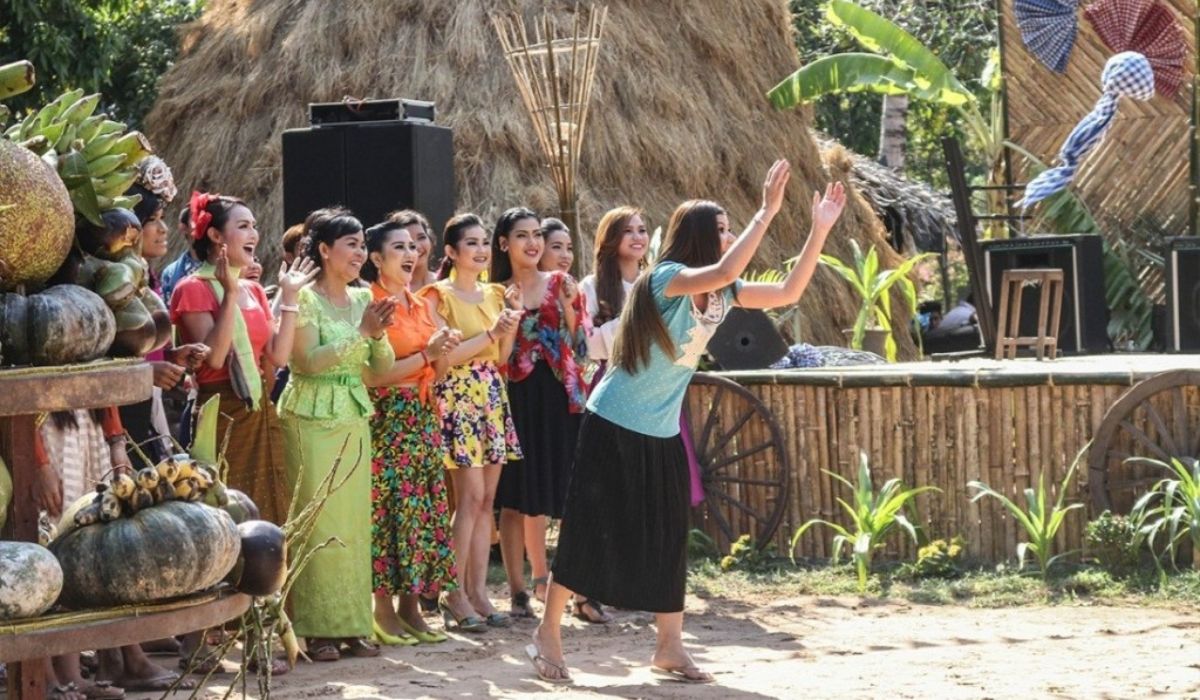
Chol Chhoung is a game played especially on the first night of Khmer New Year by two groups of men and women. Each group consists of ten or twenty people, standing in two rows facing each other. One group throws the chhoung to the other group. When caught, it is quickly thrown back to the first group. If someone gets hit by the chhoung, the whole group must jump to retrieve the chhoung while the other group sings along to the dance.
Chap Kon Kleng

Chap Kon Kleng is a game that mimics a mother hen protecting her chicks from a crow. Adults usually play this game on the first night of the New Year. Participants typically assign a strong player to act as the hen protecting her "flock" of chicks, while another player is chosen as the "crow." While both sides sing a bargaining song, the crow tries to catch as many chicks as possible as they hide behind the hen.
Bos Angkunh

Bos Angkunh is a simple game involving throwing Angkunhs to hit the target Angkunhs. The style expands into five more stages beyond the throwing stage. Both styles end with a punishment activity called Jours, where members of the winning team are performed with members of the losing team. The Jours activity is performed by using Angkunghs to hit the knees of the losing team.
Leak Kanseng
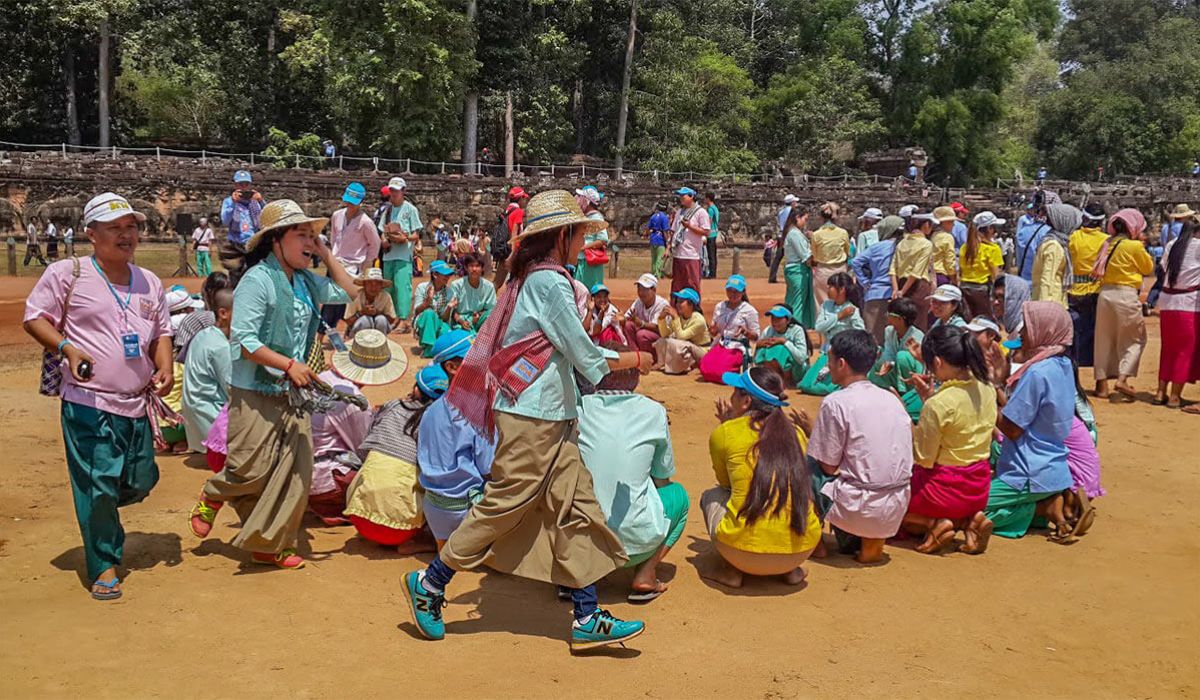
Leak Kanseng is a game played by a group of children sitting in a circle. One person holds a "kanseng" (Cambodian scarf) twisted into a circle and walks around the circle while singing a song. The walker secretly tries to place the "kanseng" behind one of the children. If the selected child realizes what is happening, they must pick up the "kanseng" and beat the person sitting next to them.
Bay Khom
Bay Khom is a game played by two children in rural or urban areas during their free time. Ten oval-shaped holes are dug into a board on the ground. The game is played with 42 small seeds, stones, or fruit seeds. Before starting the game, five seeds are dropped into each hole in the two holes located at the end of the board. Four seeds are dropped into each remaining hole in the eight holes. The first player takes all the seeds from any hole and drops one seed into other holes. That player must repeat this process until the last seed is dropped into a hole next to an empty hole. Then, they must take all the seeds from the next hole. At this point, the second player can take their turn. The game ends when all the holes are empty. The player with the most seeds wins the game. It might be similar to congkak.
8. Cambodia's Weather in April
April is one of the hottest months of the year in Cambodia, with average temperatures around 35°C and the potential to reach up to 40°C. Rainfall is still low, though occasional showers may occur towards the end of the month as the rainy season approaches (usually starting in early to mid-May). Participating in Khmer New Year celebrations during this hot weather can be challenging, so plan for shorter excursions rather than all-day tours:
-
Prepare for hot weather: Bring lightweight, breathable clothing, a hat, and sunscreen. Drink plenty of water throughout the day to stay hydrated.
-
Plan your Angkor Wat visit: To avoid the intense midday sun, try to explore Angkor Wat from dawn until around 11 AM. This is the coolest time of the day, and you'll have a more enjoyable experience exploring the temples.
-
Seek air-conditioned spaces: Consider filling your afternoons with activities in air-conditioned environments. The Angkor National Museum is a great choice – you can learn about the history and culture of Angkor Wat in a cool and comfortable setting.
9. Tips for Traveling During Cambodian New Year Festival

-
Book early: With many people traveling with their families, it's important to book accommodations in advance to avoid disappointment.
-
Respect local customs: When visiting Cambodia during the New Year, it's important to be mindful of local customs and traditions. Dress modestly and avoid using cameras in religious settings.
-
Try local cuisine: New Year is a great time to sample traditional Cambodian food. Don’t miss the opportunity to try dishes such as fish amok, kdam chaa (stir-fried crab), and bai sach chrouk (pork and rice).
-
Attend the Water Festival: If you're in Cambodia during the New Year, make sure to visit the Water Festival. It’s a unique and lively experience that you won’t want to miss.
Cambodian New Year is a time for Cambodians to celebrate and reflect. Whether you're visiting Cambodia or just learning about the country's customs, this guide provides a comprehensive look at New Year traditions and tips for experiencing the festival. With its unique customs and vibrant atmosphere, Cambodian New Year is a celebration not to be missed.
Source: Wikipedia